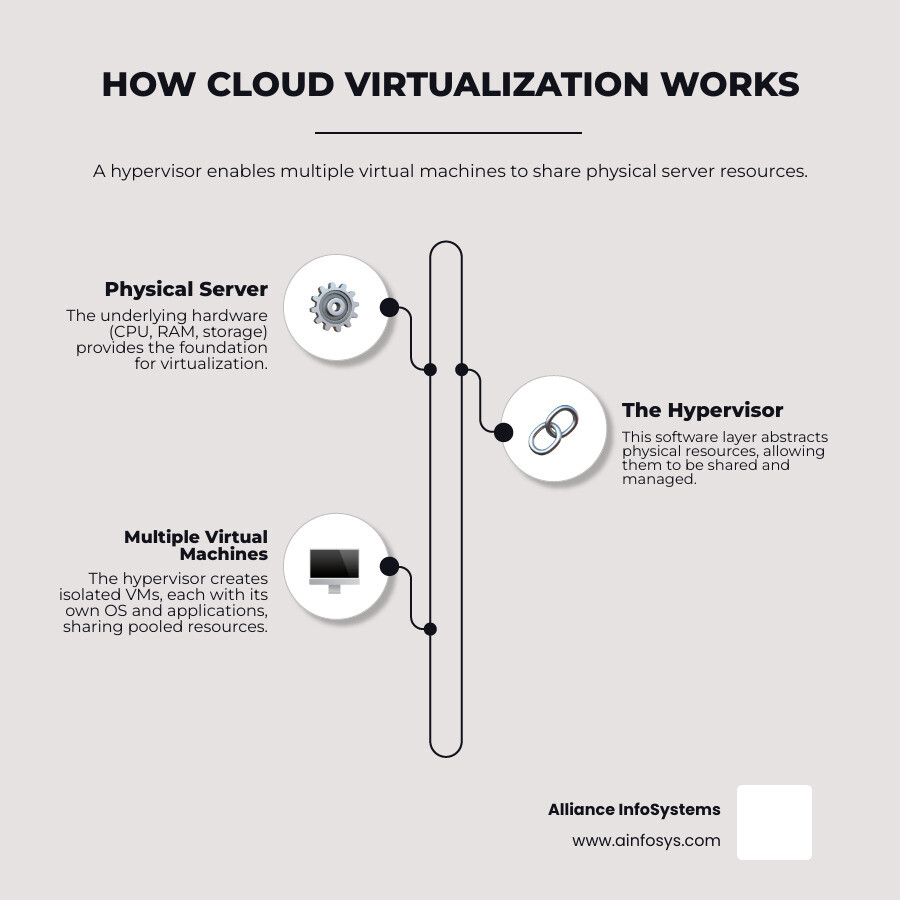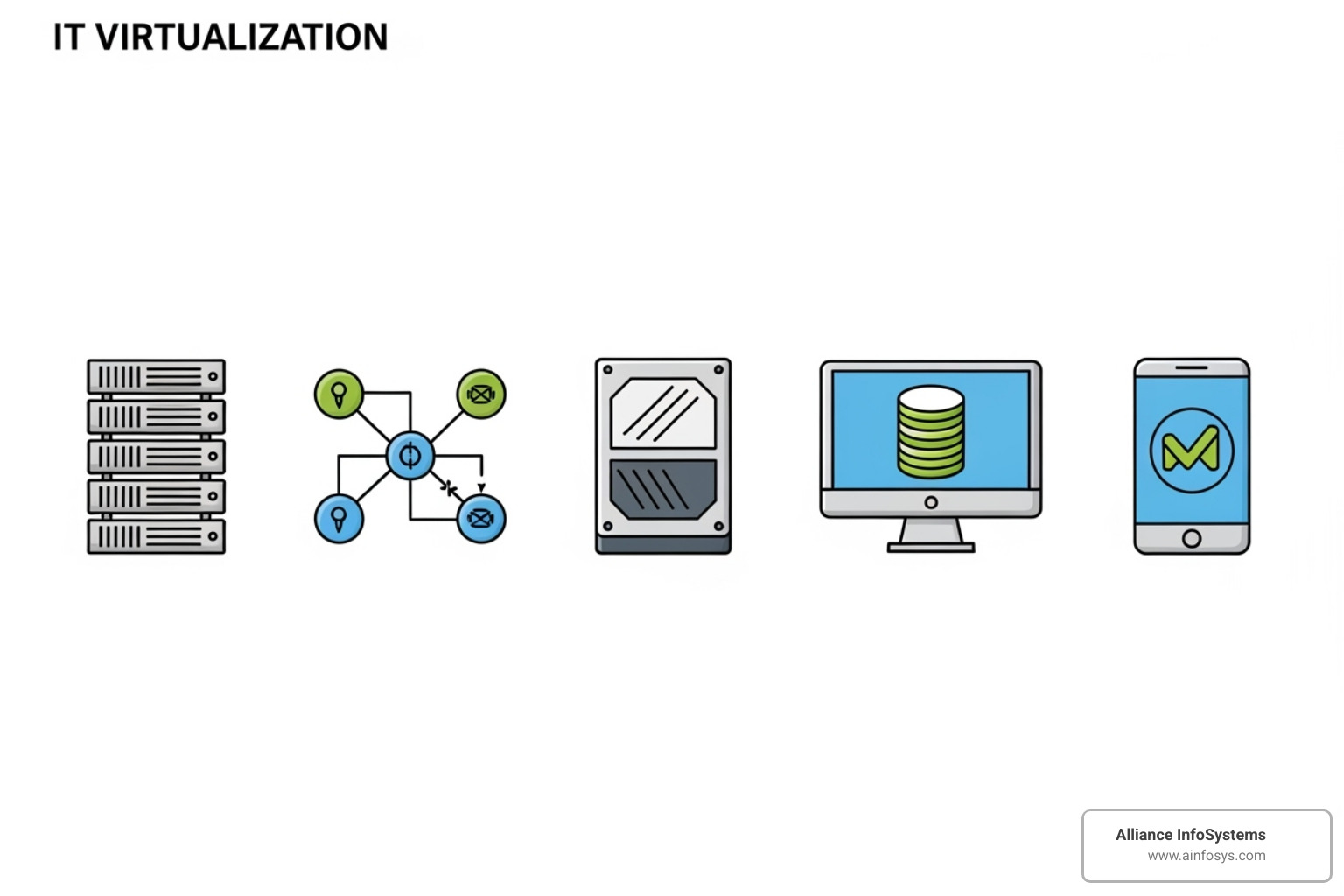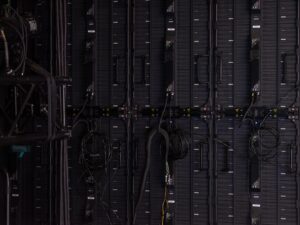Cloud Virtualization Services: Definitive Guide 2025
Why Cloud Virtualization Services Are Essential for Modern Business
Cloud virtualization services are changing IT infrastructure by allowing multiple virtual machines to run on shared physical servers in the cloud. Instead of owning and maintaining expensive hardware, companies can access computing resources on-demand through providers like Microsoft Azure, Google Cloud, and AWS.
Key cloud virtualization services include:
- Infrastructure as a Service (IaaS) – Virtual servers, storage, and networking
- Desktop as a Service (DaaS) – Virtual desktops accessible from any device
- Platform as a Service (PaaS) – Development platforms without infrastructure management
- Managed virtualization – Fully managed virtual environments with 24/7 support
The shift to cloud virtualization is rapid, with over 95% of Fortune 500 companies using Azure and businesses reporting significant compute cost savings compared to on-premise servers. This technology gives small and medium businesses enterprise-level capabilities without the massive upfront investment or specialized staff.
The main benefits are:
- Cost reduction – Pay only for what you use
- Scalability – Add or remove resources instantly
- Reliability – 99.9%+ uptime guarantees
- Security – Enterprise-grade protection included
- Flexibility – Access from anywhere, any device
However, with many options available, choosing the right service can be challenging due to varying pricing models, features, and technical jargon.
Understanding the Fundamentals of Cloud Virtualization
Cloud virtualization services use software to make one powerful computer act like many separate computers. This technology creates a layer between the physical hardware and the programs, allowing multiple virtual computers—each with its own operating system—to share a single physical machine. This process maximizes the value and efficiency of the server hardware.
What are the key components?
Three main components work together in virtualization:
-
Virtual Machines (VMs) are digital computers within physical computers. Each VM has its own virtual processor, memory, and storage, and runs its own “guest” operating system and applications, unaware it’s sharing resources. Because VMs are essentially files, they are highly portable and easy to back up or move.
-
Hypervisors are the software that manages the virtual environment, allocating physical resources to each VM. Type 1 (bare-metal) hypervisors install directly on the server hardware for maximum performance and are common in data centers. Type 2 (hosted) hypervisors run as applications on an existing OS, ideal for testing and development.
-
Resource pooling combines all physical computing power—processors, memory, storage, and network capacity—into a large, shared pool. The hypervisor draws from this pool to provide each VM with the resources it needs on demand.
How is it different from traditional virtualization?
Traditional virtualization required businesses to buy, manage, and maintain their own physical servers and data centers. This involved significant upfront capital expenditure (CapEx) and often resulted in underused hardware.
Cloud virtualization changes this model by allowing you to rent infrastructure instead of owning it. This shifts IT spending from a large upfront investment to a predictable operating expense (OpEx).
-
On-demand resources let you launch new VMs in minutes. You can scale capacity up for a project and scale back down when it’s finished, following a pay-as-you-go model.
-
Managed services mean the cloud provider handles all backend maintenance, including software updates, hardware replacement, and security monitoring. This frees your IT team to focus on business growth.
-
Global scale allows you to deploy applications in data centers around the world, closer to your customers, for better performance without building new physical locations.
-
High availability is built-in. If a server fails, your VMs are automatically moved to healthy hardware, ensuring business continuity.
For a deeper dive, see our comparison of Cloud Computing vs. Virtualization and learn the Going Cloud Server: Pros and Cons.
The Core Types of Virtualization in the Cloud
Virtualization can abstract and optimize every part of your IT infrastructure, creating a flexible software-defined infrastructure where resources are managed through code. This approach applies to every layer of the technology stack.
Modern cloud virtualization services work across your entire technology stack. For more on how this technology is evolving, see more on the evolution of virtualization and our resources on Virtualization.
Server and Data Center Virtualization
Server virtualization allows one physical server to host multiple independent virtual machines, each with its own operating system. This physical server consolidation dramatically reduces your hardware footprint, leading to lower power, cooling, and space costs. The primary benefit is increased server utilization, as you get more value from your hardware. Instead of ordering new physical servers, you can simply create new VMs to add capacity. To learn how to modernize your setup, see how to Revolutionize Your Data Center.
Storage and Network Virtualization
Storage virtualization pools various storage devices like Storage Area Networks (SANs) and Network Attached Storage (NAS) systems into a single, manageable resource. This simplifies administration by presenting all storage through one interface.
Software-Defined Networking (SDN) allows you to create and manage logical switches, routers, and firewalls in software. Network functions that once required dedicated hardware can now run on standard servers, allowing you to deploy a new firewall rule or prioritize traffic through software configuration instead of physical changes.
Desktop and Application Virtualization
Virtual Desktop Infrastructure (VDI) moves employee desktops to the data center. Users can access their full desktop environment from any device, with all computing happening in the cloud. This is ideal for remote access and offers huge centralized management benefits, as software updates and security are handled on the server. All data remains in the secure data center instead of on individual laptops.
Application streaming delivers individual applications to users, allowing them to run software on incompatible operating systems (e.g., a Windows app on a Mac). To help choose the right approach, read our comparison of Virtual Servers vs. Virtual Desktops.
CPU and GPU Virtualization
Virtual CPUs (vCPUs) allow a single physical processor to be shared among multiple VMs. Modern processors have instruction sets designed for this, making it highly efficient.
GPU virtualization is critical for demanding tasks like AI/ML workloads, High-Performance Computing (HPC), and graphics rendering. Shared GPUs (vGPUs) allow multiple VMs to access a single powerful graphics card, making expensive GPU hardware more cost-effective. This provides on-demand access to enterprise-grade GPU power without purchasing dedicated hardware that might sit idle.
Key Business Benefits and How to Evaluate Cloud Virtualization Services
Adopting cloud virtualization services is a strategic investment that transforms business operations. The benefits extend beyond moving servers, impacting resource efficiency, high availability, disaster recovery, and business continuity to create a more resilient and agile organization.
Instead of maintaining physical servers, your IT team can focus on growth projects. You pay only for resources you use, and your systems can scale automatically. Explore these advantages in our guide on Understanding Business Benefits of Virtualization.
Evaluating Resource Efficiency and Cost Optimization
Cloud virtualization dramatically improves resource efficiency and cuts costs. Traditional servers are often underused, running at just 10-15% capacity. Virtualization allows multiple VMs to share hardware, increasing utilization.
- Pay-as-you-go model: This shifts IT spending from large upfront capital investments to a predictable monthly operating expense. You pay only for the compute, memory, and storage you consume.
- Discount options: Committed use discounts offer large savings for long-term usage, while sustained use discounts apply automatically for consistent workloads. Spot instances provide the deepest discounts for non-critical tasks.
- Rightsizing: Cloud monitoring tools help you analyze actual usage and adjust VM resources accordingly, preventing over-provisioning and unnecessary costs.
- Staff productivity: With the provider managing hardware and updates, your IT team can focus on strategic initiatives.
These factors lead to substantial savings, as detailed in our guide on 4 Ways Cloud Reduces Business Costs.
Assessing Scalability and High Availability
Cloud virtualization eliminates the need to over-provision infrastructure for peak demand.
- Automatic scaling: Resources are added or removed based on real-time demand, ensuring performance during traffic spikes without manual intervention.
- Load balancing: Incoming requests are distributed across multiple VMs to prevent any single instance from being overwhelmed, keeping applications responsive.
- High availability: Cloud providers offer Service Level Agreements (SLAs) guaranteeing high uptime percentages (e.g., 99.9% or more). Features like live migration allow VMs to move between physical servers for maintenance without any downtime.
- Disaster recovery: Replicating VMs to different geographic regions is more affordable and robust than maintaining a duplicate physical site. In a disaster, backup systems can be online in minutes.
Learn more by reading How Cloud Server Computing Works.
Understanding the pricing models for cloud virtualization services
Cloud pricing is based on several components, making it more predictable than traditional IT budgeting.
- Compute costs: Billed for the virtual CPU cores and memory used, often with per-second billing after a one-minute minimum. You don’t pay for idle time.
- Storage pricing: Varies by type (e.g., standard HDD vs. high-performance SSD) and amount, billed per gigabyte per month.
- Network charges: Typically apply only to data leaving the cloud (egress). Uploading data is usually free, and egress prices often decrease with volume.
- Additional services: Costs for services like load balancers or managed databases are added to the bill, but they often replace more expensive on-premise solutions.
Most providers offer free tiers and credits for new customers. Use their cost calculators to estimate monthly expenses based on your expected usage.
Implementation: Migration, Security, and Management
Moving to cloud virtualization services is a transformative process that requires a well-planned strategy. The shift impacts your entire IT approach, from governance to compliance. We focus on comprehensive Cloud solutions that empower your organization.
Migrating to a Cloud Virtualization Platform
Successful cloud migration requires careful planning, much like moving to a new city.
- Lift-and-shift: This common starting point involves moving existing VMs to the cloud with minimal changes. It’s the fastest approach, and modern tools can make it very efficient.
- Re-platforming: This involves making small modifications to take advantage of cloud features, such as switching to a managed database service, without a major application overhaul.
- Refactoring: This means redesigning applications to be fully cloud-native. While it requires more effort, it yields the greatest long-term benefits in performance and cost.
A phased rollout is essential. Start with non-critical workloads to test the process before moving production systems. Testing and validation at each stage are crucial to ensure applications perform correctly in the new environment. Modern migration tools from cloud providers can automate much of this process. Our Cloud Migration Guide provides a detailed walkthrough.
Security Considerations for Cloud Virtualization Services
Cloud security uses a shared responsibility model. The provider secures the cloud (physical infrastructure, networks, hypervisor), while you secure what’s in the cloud (data, applications, OS, access policies).
- Hypervisor security: This is critical. Cloud providers invest heavily here, offering features like Confidential VMs to encrypt data in use and Shielded VMs to protect against boot-level malware.
- Network segmentation: Isolate different parts of your virtual environment to limit the spread of potential threats.
- Identity and Access Management (IAM): Implement the principle of least privilege, giving users and services only the permissions they absolutely need.
- Data encryption: Encrypt data both at rest (stored) and in transit (moving between systems). Ensure these services are enabled for all sensitive information.
- Continuous monitoring and logging: Use these tools to detect suspicious activity and respond to incidents. Combine this with regular vulnerability management to scan and patch systems promptly.
We address common security concerns in our guide to Cloud Myths Debunked.
How Virtualization Underpins Cloud Service Models
Virtualization is the foundation for all major cloud service models by abstracting physical hardware into flexible, on-demand resources.
- Infrastructure as a Service (IaaS): You directly use virtualized resources like VMs, virtual networks, and storage. You manage the OS and applications, while the provider manages the physical hardware and hypervisor.
- Platform as a Service (PaaS): The provider offers a complete development environment (OS, databases, web servers) running on virtualized infrastructure. Developers can focus on code without managing the underlying platform.
- Software as a Service (SaaS): Complete applications are delivered over the internet, running on the provider’s virtualized infrastructure. Virtualization enables the multi-tenancy that makes SaaS economically viable.
This resource abstraction allows a single data center to efficiently serve thousands of customers. Learn more in our exploration of In-Depth Cloud-Based Services.
Virtualization vs. Containerization: Making the Right Choice
When deploying applications, you’ll encounter two key technologies: virtualization and containerization. While both improve efficiency, they operate differently. Virtual machines (VMs) are like separate apartments, each with its own OS and full hardware isolation. Containers are like hotel rooms sharing the host OS kernel, making them much more lightweight and faster.
The main difference is the isolation level. VMs use a hypervisor for hardware-level isolation, making them large but highly secure. Containers use OS-level virtualization, sharing the host kernel, which makes them smaller and faster to launch. This difference in resource usage means you can run more containerized applications on the same hardware compared to VMs.
| Feature | Virtual Machines (VMs) | Containers |
|---|---|---|
| Isolation | Hardware-level via hypervisor; each VM has its own OS | OS-level via container engine; shares host OS kernel |
| Size | Larger (GBs), includes full OS | Smaller (MBs), includes only app and dependencies |
| Startup Time | Slower (minutes), requires OS boot | Faster (seconds), no OS boot |
| Portability | Highly portable, can run on any compatible hypervisor | Extremely portable, runs consistently across environments |
| Resource Usage | Higher overhead due to separate OS for each VM | Lower overhead, more efficient resource utilization |
| Use Case | Running multiple OS, legacy apps, full isolation | Microservices, CI/CD, rapid deployment, cloud-native apps |
When to Use Virtual Machines
VMs are the best choice in several key scenarios:
- Legacy applications: When an application requires a specific, older operating system or configuration that is difficult to containerize.
- Multiple operating systems: When you need to run different OS environments (e.g., Windows and Linux) simultaneously on the same physical server.
- Full isolation requirements: For sensitive workloads or regulated industries where the hardware-level separation of VMs is necessary for security and compliance.
- Stateful applications: For applications like databases that require a stable, persistent, and dedicated environment.
- Infrastructure consolidation: To replace numerous physical servers with fewer, more powerful machines running multiple VMs.
When to Use Containers
Containers are ideal for modern application development:
- Microservices architecture: When breaking large applications into small, independently deployable services.
- DevOps and CI/CD pipelines: To package applications with their dependencies for consistent deployment across development, testing, and production.
- Lightweight applications: For web servers, APIs, and other services that don’t require a full OS.
- Fast deployment and scaling: When rapid, near-instantaneous scaling is needed to meet variable demand in cloud virtualization services.
- Stateless applications: For applications that don’t store persistent data and can be easily scaled or replaced.
Modern platforms increasingly allow VMs and containers to run on unified infrastructure, offering the flexibility to choose the right tool for each workload.
Frequently Asked Questions about Cloud Virtualization
Transitioning to a virtualized cloud environment can seem complex. Here are answers to some of the most common questions we’ve encountered while helping Maryland businesses over the past 20 years.
What’s the first step to adopting cloud virtualization?
The first step is a thorough assessment of your current IT environment, workloads, and business goals. This strategic planning phase involves inventorying your applications, identifying system dependencies, and defining clear objectives for cost, performance, and scalability. A proper evaluation helps you create a successful migration plan and prevents costly mistakes, such as finding that a critical legacy application is incompatible with the new environment.
How does cloud virtualization impact IT team roles?
Cloud virtualization lifts IT roles, shifting the focus from routine hardware maintenance to more strategic work. Instead of managing physical servers, your team will concentrate on performance optimization, security management, automation, and cloud governance. This evolution allows IT professionals to become strategic partners who help the business innovate and grow, rather than simply maintaining infrastructure. While there is a learning curve, the new responsibilities are often more engaging and valuable.
Can I run specialized or legacy applications using cloud virtualization?
Yes. One of the primary advantages of cloud virtualization services, especially IaaS, is the ability to host legacy applications. Virtualization allows you to create an environment that precisely mimics your old on-premise setup, including the specific operating system, drivers, and configurations your application requires. This means you can move critical software, such as a 15-year-old application running on an outdated OS, to the cloud without needing to refactor or replace it. The application continues to run as it always has, but with the added benefits of cloud infrastructure like improved disaster recovery and scalability.
Conclusion
Cloud virtualization services have revolutionized IT infrastructure. What once required large capital investments in physical hardware can now be accessed on-demand. This shift enables businesses to scale for peak demand in minutes, test new ideas without buying hardware, and ensure business continuity even if a physical office is unavailable.
The strategic advantage is agility. Cloud virtualization allows you to respond to market changes faster, grow without technical limitations, and free your IT team from routine hardware maintenance. Your staff can then focus on initiatives that drive business growth.
At Alliance InfoSystems, we’ve been guiding Maryland businesses through these transitions since 2004. We understand that every business is unique, and we tailor our solutions to your specific challenges, whether you’re a startup concerned with scaling costs or an established company managing legacy systems. With over 20 years of experience, we are committed to your success.
The journey to the cloud doesn’t have to be overwhelming. With the right partner, it’s an opportunity to modernize, optimize, and prepare for the future.
To steer the complexities of virtualization and select the right services for your business, partner with an experienced IT provider. Explore our comprehensive Cloud Computing solutions and our Cloud Virtualization Services to start building a scalable, secure, and cost-effective IT future.








